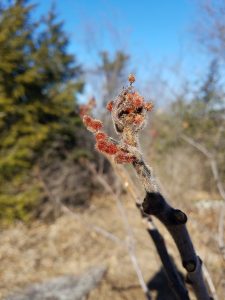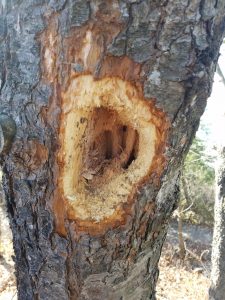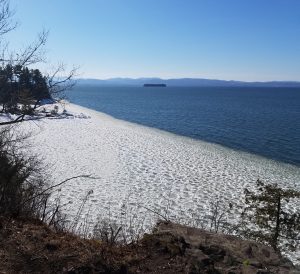This past Sunday I ventured to my spot at Oakledge Park. It was a very sunny, cold day with considerable wind gusts. There was little-to-no snow on the land and buds were starting to become evident on the trees. There were also quite a few birds all around my spot, my favorite of which being a fat female cardinal. I was not able to get her picture, but she was along the trail leading up to my spot, in a tree.

There was a new, impressive, possibly man-made hole in one of the trees on my spot, which baffled me. I have never seen a bird make a hole this big. My best guess is that maybe a bird started the hole and it was then worsened by a human. It was a surprisingly aggressive new sight.

Another interesting thing that I noticed, although not part of my site, was the ice on the lake. There was a thin sheet that extended out from the shoreline that moved with the waves. I am wondering how this formed, if it was water that froze quickly and then had snow accumulate on top of it, or if it is some sort of receding ice melt. This was a really neat phenomenon to witness.

After paging through Wetland, Woodland, Wild, I decided to classify the natural community of my place as an Upland Natural Community, specifically as an upland cliff. I am not entirely sure if it is a Temperate Acidic Cliff or a Temperate Calcareous Cliff, but I am leaning more towards the Calcareous option because they are more abundant in the Champlain Valley. There is also ample shrubbery, which is a key habitat aspect of the Calcareous cliff.
After plugging Oakledge Park into Biofinder, I learned that there is actually had quite a lot of rare plant species throughout the area. There also seems to be some high-priority animal crossings around the park’s edges. In my area specifically, both of these things seem to be existent. I would say that according to Biofinder, Oakledge is a very ecologically special place worth protecting. I had no idea that it had particularly rare or uncommon species present, and knowing this now makes me even more excited about my spot. It is funny how we go about our lives visiting areas with little-to-no information about the species that live there.
Wetland, Woodland, Wildland Source: http://www.vtfishandwildlife.com/common/pages/DisplayFile.aspx?itemId=245022